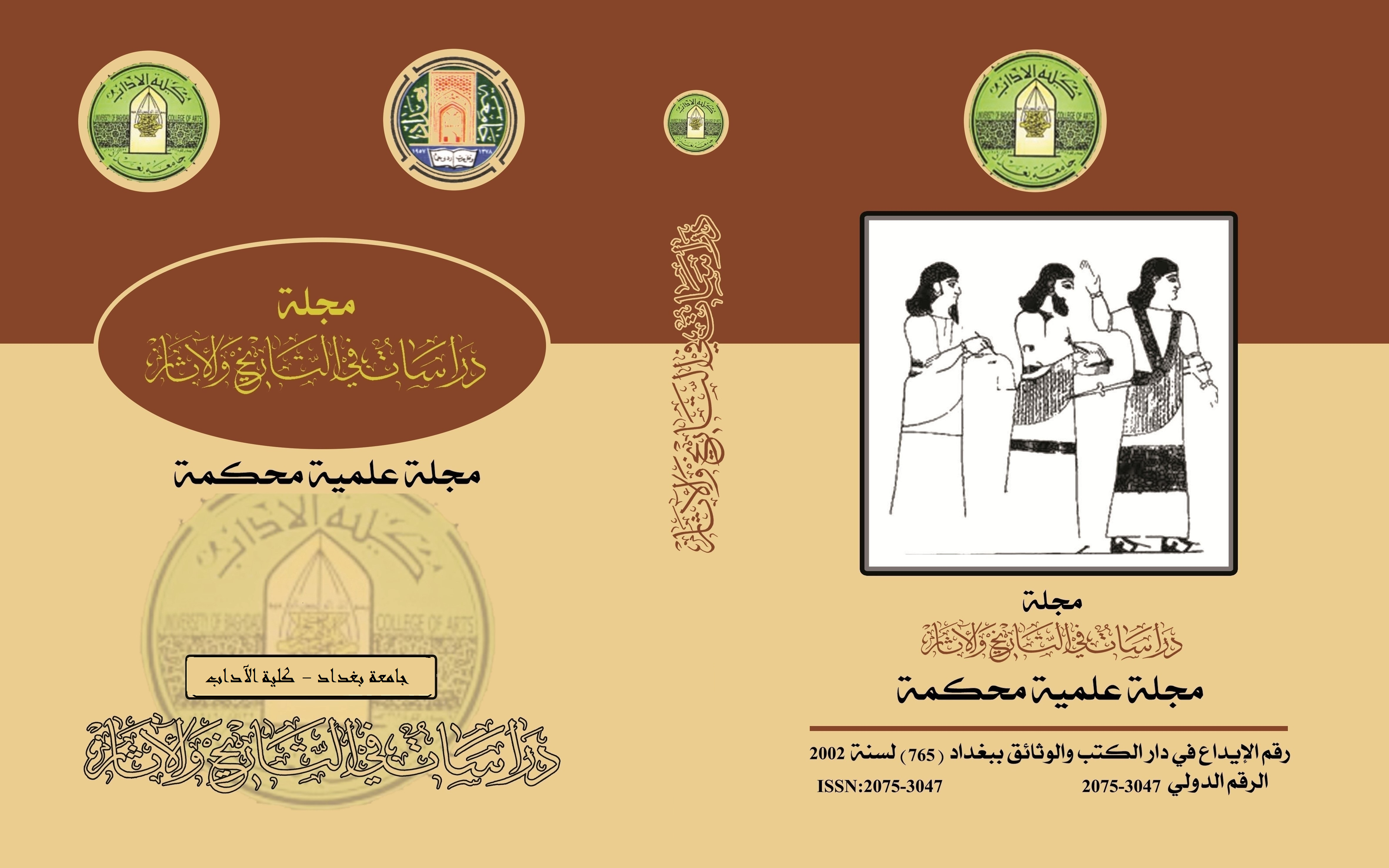صيانة وترميم لوح حجري إسلامي من العصر العثماني المتأخر
الكلمات المفتاحية:
صيانة، ترميم، تنظيف، تقوية، لصق، توثيق، ملء الفراغات، لوحالملخص
ان الطبيعة غنية بكثير من أنواع الصخور والأحجار التي استغلها الإنسان في جميع العصور كمصدر من مصادر مواد البناء، او في استخدامات اخرى، لصنع كثير من الأدوات والأواني والتماثيل، وأصبحت مادة مطاوعة التشكيل بالرغم مما يبدو عليها من صلابة، فأمكن بها التحكم في عمل العقود المتنوعة والمسلات والأعمدة، باستخدام المطارق والأزاميل.
ولان الأحجار مسامية بطبيعتها، فقد أصبحت عرضة لتسرب الأملاح داخلها سواء أثناء حالتها الصخرية أو بعد قطعها وبناءها. وأثناء خروج تلك الاملاح منها بسبب الجفاف وارتفاع درجات الحرارة عند سطوحها، تصبح على شكل تزهرات متبلورة أو بلورات دقيقة تعمل على تفتيت سطوحها وتدمير تماسك حبيباتها. وهي تتعرض الى عوامل التلف البيولوجية، والفيزيائية والكيميائية، والبشرية.
المراجع
_ الطائي، إبراهيم مؤيد، النصوص الكتابية غير المدروسة في مساجد خلال العصر العثماني، رسالة ماجستير غير منشورة، جامعة الموصل، 2011
_ الجميلي، ميادة يوسف فرحان، كتابات الموصل وخطوطها الباقية في المساجد الجامعة خلال العصر العثماني حتى نهاية القرن الثاني عشر الهجري، رسالة ماجستير غير منشورة، جامعة الموصل، 2007
_ الجعيفري، ضياء نعمة محمد، البيوت السكنية المكتشفة في مدينة بلد (اسكي موصل)، رسالة ماجستير غير منشورة، جامعة بغداد، 2007
_ الرفاعي، بلال، صناعات الدهانات، 2014
_ الجميلي، عامر عبد الله، الخط العربي في الموصل اواخر العهد العثماني، مجلة أوراق موصلية، مركز دراسات الموصل، جامعة الموصل، العدد 6، 2004
_ ادم، محمود عبد الحافظ محمد، دراسة تحليلية مقارنة في تلف وعلاج وصيانة المباني الاثرية متعددة مواد البناء بواحتي الخارجة والداخلة – تطبيقاً على بعض المباني الاثرية المختارة، أطروحة دكتوراه،2012، جامعة القاهرة
_ الروسان، فرح، تعريف اشعة جاما،2021
_ القيسي، باهرة عبد الستار، معالجة وصيانة الآثار، دراسة ميدانية، بغداد , 1981
_ النقشبندي، علي السيد ناصر، معالجة وترميم الاثار، مجلة سومر، العدد 37، 1981
_ المحاري، سلمان احمد، حفظ المباني التاريخية، الامارات، ايكروم _ الشارقة، 2017
_ بدر الدين، بلعيبود، دراﺳﺔ ﻓﻌﺎﻟﯾﺔ ﺗﻘوﯾﺔ اﻟﺣﺟﺎرة اﻷﺛرﯾﺔ دراﺳﺔ ﺗطﺑﯾﻘﯾﺔ ﻋﻠﻰ ﻋﯾﻧﺎت ﻣن اﻟﺣﺟﺎرة اﻟرﻣﻠﯾﺔ أطروحة دكتوراه، جامعة الجزائر،2014
_ حسام الدين، وائل جمال، عوامل تلف الآثار الرخامية، 2017
_ محمود، عبد الله، التنظيف بالليزر
_ غنيمات، اسلام، الماء المقطر، 2019
_ عطية، عبد الرحيم حنون، تقنية النانو وتطبيقاتها في علاج الطوب واللبن المستخدم في تشييد الأبنية الاثرية دراسة تطبيقية على بعض النماذج من جنوب العراق، أطروحة دكتوراه، جامعة القاهرة،2015
_ لقمة، نادية، الموسوعة العلمية لمواد الصيانة والترميم، ب ت
_ فضل الله، جعفر زهير، صيانة وترميم المكتشفات الاثرية، دار قابس 2006
_ نظام، حمزة، الطرق المتطورة في ترميم حجر البناء في الأبنية الاثرية في الساحل السوري، رسالة ماجستير جامعة اللاذقية، سوريا، 2004
المصادر الأجنبية:
_ Daniel D. Lukenbill, The Annals of Sennacherib, Ph. University of Chicago,1924
_ Joan M. Schwartz, The Geography Lesson: Photograph and the Construction of Imaginative geographies, Journal of historic geography ,1996
_ Eric Doehne and Clifford A. Price, Stone Conservation an Overview of Current Research,2010
_ Barbara Stuart, Analytical Techniques in Materials Conservation, 2007
_ Saad Ahmed Abd Mustafa and Zaid Ghazi Saadallah, Conservation of Sculptures and wall panels of the palace of Sennacherib, 2013, Revue d’Assyriologie, volume CXV (2021)
_ Torraca. G: Porous Building Materials, material Science for Architectural Conservation, ICCROM, Rome, (2005)
_ JERRY PODANY, The Conservation of stone materials,1995
_ Donny Hamilton, Methods for Conserving Archaeological Material from Underwater Sites, Texas University,1999
_ Stephen P. Koob, The use of Paraloid B-72 as an adhesive: Its application for Archaeological Ceramics and other materials, journal Studies in Conservation, V.103,1986
_ Stephen P. Koob, Paraloid B-72®: 25 years of use as a consolidant and adhesive for ceramics and glass,1993
_ William H. Brown, acetone chemical compound,2019
_ Ione Gedye, Henry Hodges, Andrew Oddy, Notes for a short course in conservation, British Museum,1973
_ Velson Horie, Materials for conservation organic consolidants Adhesives and coatings,2010
_ Charles Selwitz, Epoxy Resins in Stone Conservation, America,1992
_ A. Pizzi and K. L. Mittal, Handbook of Adhesive Technology Third Edition,2018. P.423
_ Vantico adhesives, Adhesives and Tooling Structural Adhesives,2002
التنزيلات
منشور
إصدار
القسم
الرخصة

هذا العمل مرخص بموجب Creative Commons Attribution 4.0 International License.
:حقوق الطبع والنشر والترخيص
بالنسبة لجميع البحوث المنشورة في مجلة دراسات في التاريخ والآثار، يحتفظ الباحثون بحقوق النشر. يتم ترخيص البحوث بموجب ترخيص Creative Commons CC BY 4.0 المفتوح ، مما يعني أنه يجوز لأي شخص تنزيل البحث وقراءته مجانًا. بالإضافة إلى ذلك ، يجوز إعادة استخدام البحث واقتباسه شريطة أن يتم الاستشهاد المصدر المنشور الأصلي. تتيح هذه الشروط الاستخدام الأقصى لعمل الباحث وعرضه.
:إعادة إنتاج البحوث المنشورة من الناشرين الآخرين
من الضروري للغاية أن يحصل الباحثون على إذن لإعادة إنتاج أي بحث منشورة (أشكال أو مخططات أو جداول أو أي مقتطفات من نص) لا يدخل في نطاق الملكية العامة أو لا يملكون حقوق نشرها. يجب أن يطلب الباحثون إذنًا من مؤلف حقوق النشر (عادة ما يكون الناشر).
يطلب الإذن في الحالات التالية:
بحوثك الخاصة المنشورة من قِبل ناشرين آخرين ولم تحتفظ بحقوق النشر الخاصة بها.
مقتطفات كبيرة من بحوث أي شخص أو سلسلة من البحوث المنشورة.
استخدم الجداول والرسوم البيانية والمخططات والمخططات والأعمال الفنية إذا لم يتم التعديل عليها.
الصور الفوتوغرافية التي لا تملك حقوق لنشرها.
لا يطلب الإذن في الحالات التالية:
إعادة بناء الجدول الخاص بك مع البيانات المنشورة بالفعل في مكان آخر. يرجى ملاحظة أنه في هذه الحالة يجب عليك ذكر مصدر البيانات في شكل "بيانات من ..." أو "مقتبس من ...".
تعتبر عروض الأسعار القصيرة معقولة الاستخدام العادل ، وبالتالي لا تتطلب إذنًا.
الرسوم البيانية ، الرسوم البيانية ، المخططات ، الأعمال الفنية التي أعاد الباحث رسمها بالكامل والتي تم تغييرها بشكل ملحوظ إلى درجة لا تتطلب الاعتراف.
الحصول على إذن
لتجنب التأخير غير الضروري في عملية النشر ، يجب أن تبدأ في الحصول على أذونات في أقرب وقت ممكن. لا يمكن لمجلة الآداب نشر بحث مقتبس من منشورات أخرى دون إذن.
قد يمنحك مالك حقوق الطبع والنشر تعليمات بشأن شكل الإقرار الواجب اتباعه لتوثيق عمله ؛ بخلاف ذلك ، اتبع النمط: "مستنسخ بإذن من [المؤلف] ، [كتاب / المجلة] ؛ نشره [الناشر] ، [السنة]." في نهاية شرح الجدول ، الشكل أو المخطط.



















